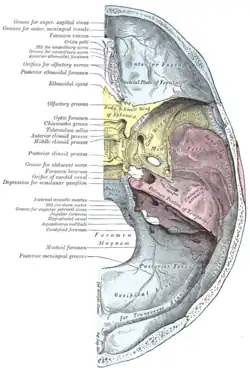| Subarcuate fossa | |
|---|---|
 Left temporal bone. Inner surface. (Subarcuate fossa not labeled, but aquaeductus vestibuli labeled at lower right.) | |
 Base of the skull. Upper surface. (Subarcuate fossa not labeled, but temporal bone is identified in pink, and "Eminentia arcuata" (i.e. arcuate eminence, corresponding to the superior semicircular canal) is labeled.) | |
| Details | |
| Identifiers | |
| Latin | Fossa subarcuata ossis temporalis |
| TA98 | A02.1.06.034 |
| TA2 | 672 |
| FMA | 56418 |
| Anatomical terms of bone | |
The subarcuate fossa is a shallow[1] depression upon the internal surface of the petrous part of the temporal bone[2] forming the wall of the posterior cranial fossa. The fossa accommodates the flocculus of the cerebellum. It is situated lateral/posterior to the internal auditory meatus.[1]
Anatomy
The subarcuate fossa is situated posteriorly[3]: 568 and superiorly[3]: 737 between the opening of the vestibular aqueduct and opening of internal auditory meatus.[3]: 568, 737
The surface of the subarcuate fossa is lined with dura mater and lodges the endolymphatic sac and duct, as well as a minute artery and vein;[3]: 568 some veins from the mucosa of mastoid antrum enter the cranial cavity at the subarcuate fossa to drain at the superior petrosal sinus - they are remnants of larger subarcuate veins of childhood and represent a possible route of intracranial infectious spread.[3]: 749
Other animals
It is extensive in most primates (except for great apes) and nearly all mammals. In these animals, the subarcuate fossa houses a part of the cerebellum, the petrosal lobe.[4][5]
References
- 1 2 Sinnatamby, Chummy S. (2011). Last's Anatomy (12th ed.). Elsevier Australia. p. 451. ISBN 978-0-7295-3752-0.
- ↑ "Fossa subarcuata". TheFreeDictionary.com. Retrieved 2023-08-01.
- 1 2 3 4 5 Standring, Susan (2020). Gray's Anatomy: The Anatomical Basis of Clinical Practice (42th ed.). New York. ISBN 978-0-7020-7707-4. OCLC 1201341621.
{{cite book}}: CS1 maint: location missing publisher (link) - ↑ Gannon PJ, Eden AR, Laitman JT (Oct 1988). "The subarcuate fossa and cerebellum of extant primates: comparative study of a skull-brain interface". Am J Phys Anthropol. 77 (2): 143–64. doi:10.1002/ajpa.1330770202. PMID 3207165.
- ↑ Jeffery N, Ryan TM, Spoor F (Aug 2008). "The primate subarcuate fossa and its relationship to the semicircular canals part II: adult interspecific variation". J Hum Evol. 55 (2): 326–39. doi:10.1016/j.jhevol.2008.02.010. PMID 18395770.
External links
- "Anatomy diagram: 34257.000-2". Roche Lexicon - illustrated navigator. Elsevier. Archived from the original on 2013-06-22.